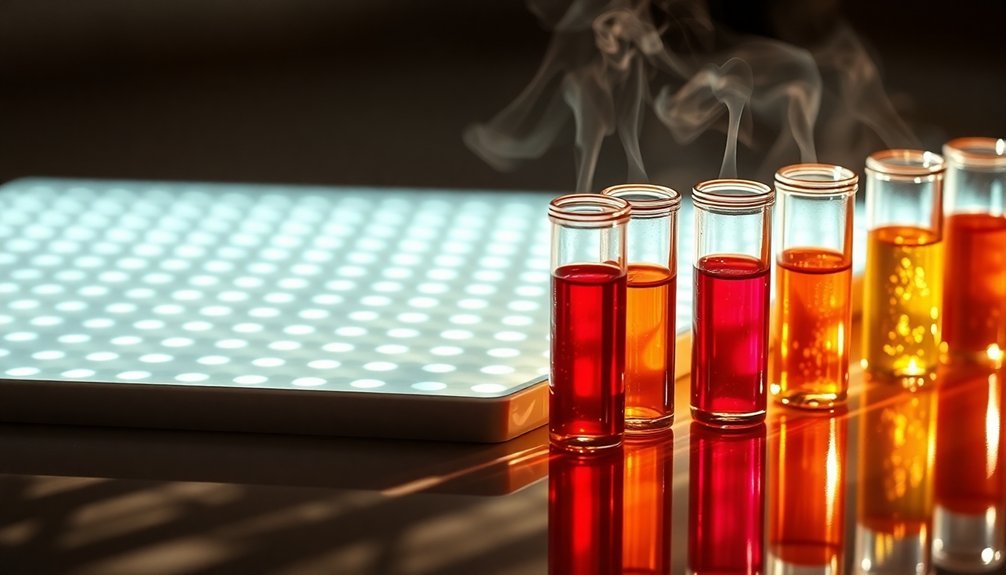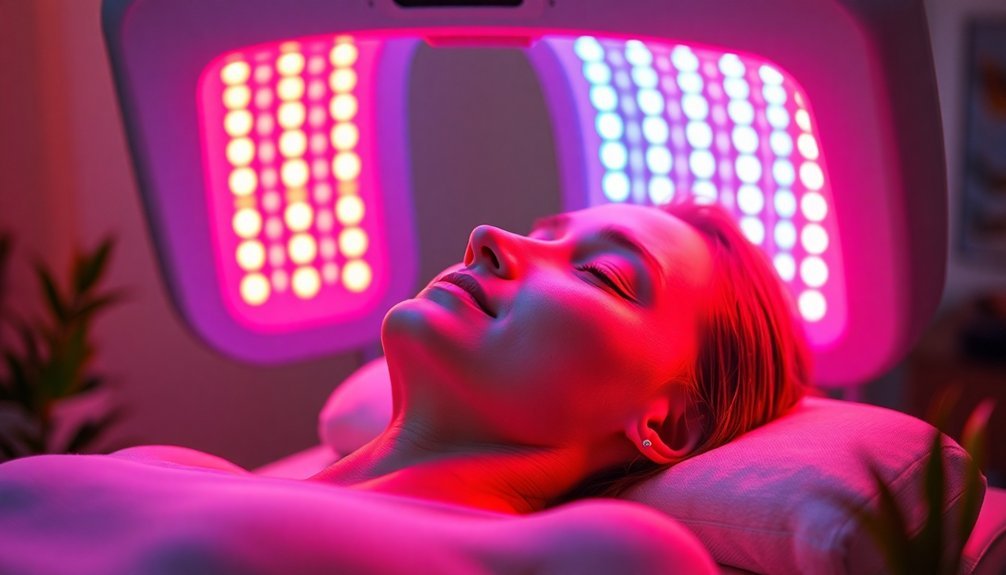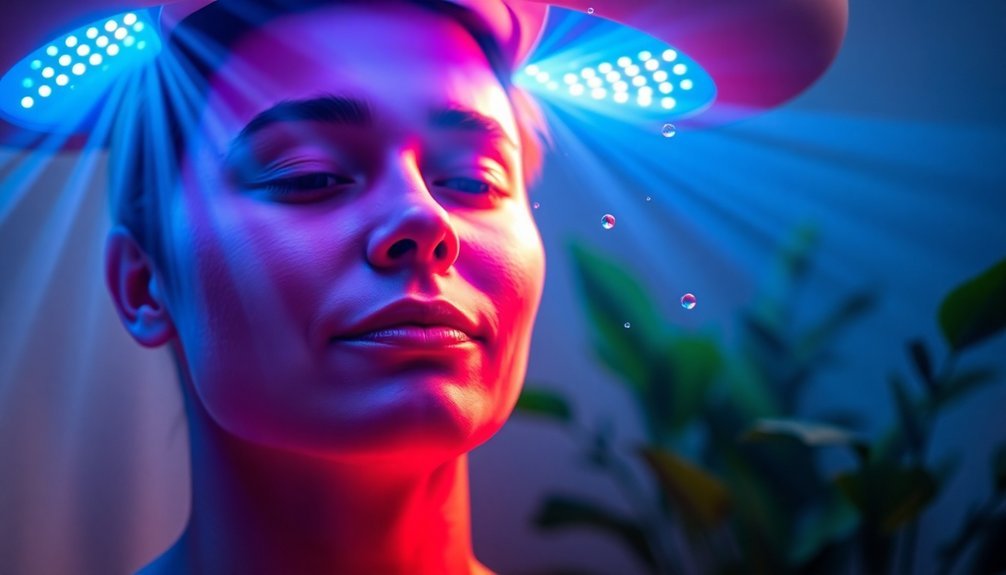Light therapy fights systemic inflammation by using specific wavelengths that penetrate the skin and boost cellular functions. These wavelengths enhance ATP production in your cells, increasing energy and reducing oxidative stress. By improving blood circulation, it encourages better oxygen delivery and waste removal. Light therapy also modulates cytokine activity, reducing pro-inflammatory cytokines like IL-6 while promoting anti-inflammatory ones like IL-10. This balance helps manage your immune response effectively. You'll notice benefits in various conditions, from arthritis to migraines. Keep exploring to uncover more about how this innovative treatment can enhance your well-being.
Mechanisms of Light Absorption

When it comes to light therapy, understanding how light is absorbed by the body is vital. Specific wavelengths, particularly red (640 nm) and near-infrared (880 nm) light, penetrate your skin and tissues to different depths. These wavelengths interact with your cellular components, reaching deeper tissues and enhancing energy production. The depth of penetration considerably influences the therapy's effectiveness.
Light absorbed by cells, especially in mitochondria, boosts energy production. This process increases ATP production and reduces oxidative stress, leading to improved cellular functions and healing. You'll notice that this interaction triggers a cascade of biological responses that aid repair mechanisms within your body.
In addition, light therapy enhances blood circulation and oxygen delivery to tissues, which is essential in removing waste products and inflammatory mediators. Thanks to this improved blood flow, inflammation resolves faster, and tissue repair accelerates. PBM utilizes low-intensity light for therapeutic effects, as highlighted by its ability to directly influence inflammation and promote healing processes.
Light therapy even upregulates angiogenesis genes, promoting the formation of new blood vessels. Therefore, understanding these mechanisms of light absorption highlights why light therapy can effectively combat systemic inflammation and enhance overall health.
Cellular and Molecular Responses
Light therapy's impact on systemic inflammation extends beyond absorption mechanisms to trigger significant cellular and molecular responses. When you undergo red and near-infrared light therapy, these wavelengths interact with mitochondrial components in your cells, boosting ATP synthesis and consequently increasing energy production. This surge in cellular energy supports essential healing processes and enhances overall cellular function, enabling your body to better manage inflammation. Additionally, this therapy promotes enhanced cellular health, which further bolsters your body's defenses against systemic inflammation.
Improved blood circulation is another important response to light therapy. Enhanced blood flow guarantees the effective delivery of oxygen and nutrients to inflamed tissues while also aiding in waste removal. This oxygenation is essential for facilitating tissue repair and reducing inflammation effectively.
Additionally, light therapy modulates cytokine activity, downregulating pro-inflammatory cytokines and upregulating anti-inflammatory ones. This modulation helps decrease the activity of inflammasomes and further reduces the overall inflammatory response within your body.
Lastly, light exposure activates protective pathways, like the Nrf2 pathway, which helps mediate anti-inflammatory responses. By supporting key cellular functions and improving metabolic health, light therapy serves as a promising tool in combating systemic inflammation and promoting recovery.
Inflammatory Marker Modulation

When you consider the impacts of light therapy, you'll notice significant changes in cytokine expression. This therapy not only reduces macrophage activation but also helps balance pro- and anti-inflammatory cytokines in your body. Understanding these modulation processes can be essential for managing inflammation effectively. Additionally, red light therapy promotes the production of anti-inflammatories and antioxidants, further aiding in the reduction of inflammation.
Cytokine Expression Changes
Over the years, the therapeutic application of photobiomodulation (PBM) has gained attention for its ability to modulate cytokine expression, particularly in the context of systemic inflammation. This technique effectively downregulates proinflammatory cytokines such as IL-1β, IL-6, and TNF-alpha, considerably reducing their expression levels. For instance, infrared light therapy can lower IL-6 secretion by up to 80% in human cell cultures.
Furthermore, PBM with a 40 Hz light flicker enhances the downregulation of key cytokines associated with inflammasome activation.
On the flip side, PBM also upregulates the anti-inflammatory cytokine IL-10, supporting a healthier inflammatory response. The 40 Hz light flicker not only augments IL-10 levels but also activates the Nrf2 pathway, reinforcing this anti-inflammatory effect.
Through mechanisms like modulating oxidative stress and calcium levels, PBM plays an essential role in a balanced immune response. It enhances the function of crucial transcription factors, which boosts the production of anti-inflammatory proteins.
Collectively, these cytokine expression changes highlight the potential of PBM in addressing systemic inflammation and promoting overall health.
Macrophage Activation Reduction
Building on the understanding of cytokine expression changes, it's clear that photobiomodulation (PBM) also plays a considerable role in reducing macrophage activation, an important factor in systemic inflammation.
PBM inhibits the neurotoxic polarization of macrophages, particularly in spinal cord injury (SCI) models, decreasing inflammatory factors like IL-1α and IL-6. This reduction helps promote better motor recovery by modulating macrophage behavior without affecting M2 macrophages, which support tissue repair.
Furthermore, your use of PBM can lead to lower levels of inflammatory mediators, enhancing recovery outcomes. PBM achieves this by downregulating CCL2 and CCL5, cytokines that attract immune cells to inflamed areas.
It's not just limited to SCI; in LPS-induced models, PBM successfully lessens macrophage activation and reduces inflammation.
To maximize these benefits, specific light wavelengths like red (650-660 nm) and near-infrared light are effective. Treatment duration also matters; daily sessions of about 30 minutes for 10 days can considerably support macrophage modulation.
Enhancing Blood Flow
By harnessing the power of red light therapy, you can considerably enhance blood flow throughout your body. This therapy uses red and near-infrared light to stimulate cellular activity, resulting in increased energy production within your cells. When light interacts with your skin, it triggers the release of nitric oxide from red blood cells, acting as a vasodilator that widens blood vessels.
Here's how red light therapy benefits your blood flow:
| Benefit | Impact on Body | Emotional Response |
|---|---|---|
| Increased Circulation | Delivers more oxygen and nutrients | Feel energized and relieved |
| Enhanced Recovery | Aids in healing damaged tissues | Experience hope and renewal |
| Waste Removal | Eliminates inflammatory mediators | Gain peace of mind |
| Skin Health | Improves the health of skin cells | Embrace a youthful glow |
| Pain Reduction | Lessens discomfort in tissues | Find comfort in relief |
With improved circulation, your body can efficiently remove waste while bolstering healing processes, ultimately combating chronic inflammation and promoting overall well-being.
Conditions Benefiting From Therapy

Light therapy offers promising benefits for a range of conditions, addressing both physical and neurological issues. If you're dealing with chronic pain, conditions like arthritis, fibromyalgia, and tendonitis might see significant relief. This therapy targets inflammation, helping to improve joint and muscle function, making daily tasks easier.
Neurological disorders also stand to gain. For example, if you're recovering from a stroke or managing Alzheimer's, red light therapy can aid in reducing neuroinflammation and promoting healing. It's also found to alleviate migraines and headaches, offering relief from debilitating symptoms.
For skin conditions like acne and psoriasis, light therapy works wonders by decreasing inflammation and enhancing skin healing. It's effective post-surgery as well, reducing both inflammation and pain.
Athletes and those with sports injuries can benefit too. The therapy accelerates recovery, minimizes muscle soreness, and helps manage conditions like carpal tunnel syndrome. By targeting exercise-related inflammation, it supports a quicker return to peak performance.
In short, light therapy presents multifaceted advantages across various conditions, giving you a powerful tool to manage and alleviate symptoms effectively.
Clinical Evidence and Research
Recent clinical trials have shown that light therapy effectively reduces pain and inflammatory markers in conditions like fibromyalgia and migraines, enhancing overall well-being.
Additionally, animal model studies confirm that PBM appreciably alters cytokine expression, highlighting its potential in managing systemic inflammation.
Clinical Trial Outcomes
How effective are clinical trials in demonstrating the benefits of light therapy for systemic inflammation? The results from various studies show promising outcomes, confirming that red and green light therapies can greatly reduce inflammation in different clinical conditions. Researchers have documented improvements in conditions such as arthritis, inflammatory skin disorders, and even neurodegenerative diseases.
Here's a quick overview of some trial results:
| Condition | Outcome |
|---|---|
| Osteoarthritis/Rheumatoid Arthritis | Reduced joint inflammation and pain |
| Inflammatory Skin Disorders | Decreased symptoms and improved healing |
| Fibromyalgia/Migraine | 50% reduction in pain intensity and frequency |
These outcomes highlight how light therapy not only alleviates inflammation but also enhances tissue repair and cognitive function. Studies reveal that light therapy improves circulation and nutrient delivery, further accelerating the healing process. With ongoing research aimed at optimizing treatment protocols, you can be hopeful about the potential of light therapy in managing systemic inflammation effectively.
Animal Model Studies
Animal model studies provide valuable insights into the effects of light therapy on systemic inflammation, supporting the outcomes observed in clinical trials. Research shows that photobiomodulation (PBM) greatly reduces pro-inflammatory cytokines and microglial activation in traumatic brain injury (TBI) models, especially with lasers at 800 nm and 808 nm, which enhance cognitive functions and alter microglial polarization.
In models of edema and hyperalgesia, lasers like 660 nm and 810 nm effectively minimize pro-inflammatory markers, demonstrating their potential to modulate chronic pain and inflammation.
When it comes to neurodegenerative conditions, red and near-infrared light therapy proves beneficial, protecting dopaminergic cells in Parkinson's disease and reducing neuroinflammation in Alzheimer's disease models. This therapy not only improves mitochondrial function but also normalizes inflammatory states in older mice.
Moreover, laser PBM showcases versatility by alleviating inflammation across various conditions, from burn wounds to obesity. By addressing systemic inflammation through control of reactive oxygen and nitrogen species and regulating multiple inflammatory pathways, animal studies reinforce the promise of light therapy as a powerful intervention.
Frequently Asked Questions
Is Light Therapy Safe for Everyone to Use?
Light therapy isn't universally safe. While most people tolerate it well, some may experience mild side effects like headaches or irritation. Always consult a healthcare provider to verify it's suitable for your individual needs.
How Long Does Each Light Therapy Session Typically Last?
Each light therapy session typically lasts 20 to 30 minutes. Start with shorter durations, gradually increasing as you become accustomed. Consistency is key—daily sessions usually yield better results, adjusting lengths based on individual response.
Are There Any Side Effects of Light Therapy?
Yes, light therapy can cause side effects like redness, swelling, and headaches. You might also experience irritation or fatigue. Following precautions and monitoring your response can help manage these issues effectively.
How Often Should Light Therapy Be Administered for Best Results?
For best results, you should administer light therapy daily. Sessions typically last 20 to 30 minutes, but for chronic pain, aim for one to two hours. Consistency and adjustments based on your response are essential.
Can Light Therapy Be Combined With Other Treatments?
Yes, you can combine light therapy with other treatments. It enhances results in skin care, exercise, and recovery from injuries, helping to improve circulation, reduce inflammation, and boost overall healing performance effectively.
In Summary
To sum up, you can see that light therapy effectively fights systemic inflammation through various mechanisms, including light absorption and enhanced blood flow. By modulating inflammatory markers and promoting beneficial cellular responses, it shows promise for those suffering from conditions linked to inflammation. Clinical evidence supports its use, making it a compelling option for managing inflammation. If you're considering light therapy, it might just be the solution you need to improve your health and well-being.





Leave a Reply